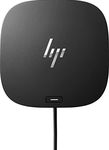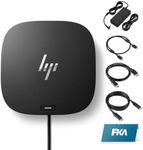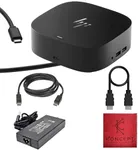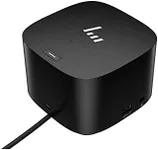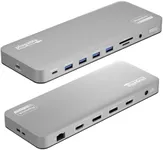Buying Guide for the Best HP Docking Stations
When choosing an HP docking station, it's important to consider how it will enhance your productivity and connectivity. A docking station can transform your laptop into a more versatile workstation by providing additional ports, charging capabilities, and support for multiple monitors. To find the best fit for your needs, you should evaluate several key specifications and understand how they align with your usage requirements.Port AvailabilityPort availability refers to the number and types of ports that the docking station offers. This is crucial because it determines what devices and peripherals you can connect to your laptop. Common ports include USB-A, USB-C, HDMI, DisplayPort, Ethernet, and audio jacks. If you need to connect multiple devices like a mouse, keyboard, external hard drive, and monitors, look for a docking station with a variety of ports. For basic use, a docking station with a few USB ports and an HDMI port might suffice. For more advanced setups, especially if you need to connect multiple monitors or high-speed data devices, ensure the docking station has the necessary ports.
Power DeliveryPower delivery refers to the docking station's ability to charge your laptop while it is connected. This is important because it eliminates the need for a separate charger and keeps your workspace tidy. Power delivery is measured in watts (W). For most laptops, a docking station with 60W to 100W power delivery is sufficient. If you have a high-performance laptop that requires more power, ensure the docking station can meet those requirements. Consider your laptop's power needs and choose a docking station that can provide adequate power to keep it charged during use.
Display SupportDisplay support indicates the docking station's ability to connect to external monitors and the maximum resolution it can handle. This is important for users who need a larger or multiple displays for multitasking or detailed work. Docking stations can support different numbers of monitors and resolutions, such as 1080p, 1440p, or 4K. If you need to connect one or two monitors, ensure the docking station supports the desired resolution and refresh rate. For professional use, such as graphic design or video editing, higher resolution support (4K) and multiple monitor support are essential.
CompatibilityCompatibility refers to whether the docking station is compatible with your specific laptop model and operating system. This is crucial to ensure that all features of the docking station will work seamlessly with your device. Some docking stations are designed specifically for certain HP laptop models, while others offer broader compatibility. Check the manufacturer's specifications to ensure the docking station is compatible with your laptop. If you use multiple devices or plan to upgrade in the future, a more universally compatible docking station might be a better choice.
Build Quality and DesignBuild quality and design refer to the physical construction and aesthetic of the docking station. This is important for durability and how well it fits into your workspace. A well-built docking station made from high-quality materials will last longer and withstand daily use. Consider the size and design of the docking station to ensure it fits well on your desk and matches your workspace's aesthetic. If you travel frequently, a compact and lightweight docking station might be more suitable.
